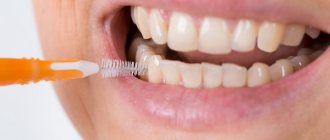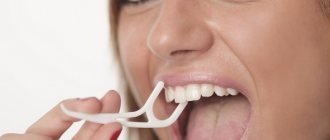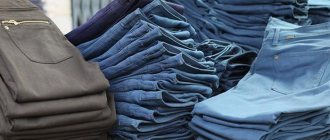Content:
- How they work
- Who needs a teeth brush?
- Classification
- What to look for when choosing
- How to use it correctly
- Yorshik is a friend of braces
Recently, dental brushes have become increasingly popular. These are special dental devices designed for the highest quality cleaning of interdental spaces. Outwardly, they are similar to standard household brushes, but they are hundreds of times smaller.
Terms of use
How to brush your teeth with a brush? They are very easy to use. The bristly rod is at an angle to the holder, making the brush very convenient. But you need to choose the size and shape individually. If it is difficult to decide which option is suitable, you can consult a dentist. The doctor measures and evaluates the anatomical structure of the teeth, after which he will choose the best model.
For cleaning to be effective, you need to choose the right angle of inclination. Dentists recommend holding the brush perpendicular to the teeth. Then you need to carefully insert it into the interdental spaces and make sure that the tip comes out on the other side of the teeth. All that remains is to perform rotational movements and move it back and forth. Then you need to take it out and rinse it under water. In this way, the interdental space of the lower and upper jaw is cleaned.
The toothbrush is used without toothpaste. It is not advisable to use force during insertion of the device, as this can damage the tooth enamel. If the product penetrates into the space between the teeth with difficulty, then a smaller diameter is required. Although the brush looks like new in appearance, it still needs to be changed weekly.
How they work
Brushes for teeth are formed by two components:
- holder;
- cleaning surface with small artificial hairs.
You can find different types of them on sale. The products differ from each other in:
- rigidity;
- quality of lint;
- method of fastening the cleaning surface;
- size of the working surface.
If the dental brush is of high quality, it will not damage mucous membranes or scratch soft tissues. After using it, your gums will not begin to bleed (however, a lot depends on the correct use of the dental accessory).
Contraindications
There are practically no restrictions on use. The device is successfully used by adults and children. The sooner a child learns what a dental brush is, the lower the risk of accumulation of all types of plaque.
Note! Even periodontitis is not an obstacle to using a cylindrical “mini-brush”. When gums are bleeding, a product with softer nylon bristles becomes a salvation for the patient. A regular brush causes severe pain and increases bleeding. The brush delicately but efficiently cleans dental tissue and does not scratch inflamed gums.
Read more about periodontitis here; about bleeding gums is written here; about the treatment of gum inflammation is written in this article.
Who needs a teeth brush?
The product improves oral hygiene and is therefore useful to absolutely anyone. It is especially important for people to use it:
- who have braces installed;
- wearing leveling plates;
- prone to rapid formation of plaque and tartar;
- with large interdental spaces;
- with malocclusions that do not allow proper oral hygiene;
- those suffering from frequent gum disease;
- with crowded teeth;
- with hard-to-reach indigenous units;
- accustomed to drinking coffee;
- addicted to tobacco.
If a person buys a dental brush, he will not go wrong. This device will immediately become his favorite assistant. Be sure to try it!
How to brush teeth with braces?
Brushing your teeth is a must if you wear braces. The procedure takes 10 minutes or more - it all depends on how easily you can use a special orthodontic toothbrush for braces . General recommendations for daily cleaning:
- Remove all removable elements of the bracket system and thoroughly clean them using water and special products.
- Rinse your mouth with water to remove all small food particles.
- Clean your teeth using horizontal and vertical movements. The locks of brace systems are cleaned only vertically.
- Finish the procedure using specialized brushes, cleaning the interdental space.
- Rinse your mouth with mouthwash and return all elements of the orthodontic frame to their place.
If you wear a bite correction system for more than six months (and this almost always happens), you must also undergo a special procedure in the clinic. Professional cleaning is required every six months. It allows you to remove plaque and other contaminants that are very difficult to remove on your own. This procedure also reduces the risk of inflammation on the gums or palate.
Classification
Conventionally, all existing dental brushes can be divided into three large groups:
- Cylindrical. Along the entire perimeter of the working part there are fibers of the same length. They are optimal for caring for large spaces between teeth and gums. Allows high-quality processing of the necks of units covered with crowns.
- Cone-shaped. The bristles on such devices are arranged in the shape of a cone. The long ones are at the base, the short ones (about one millimeter) are at the top. Cone-shaped brushes should be used to remove plaque from narrow interdental areas. They are an excellent alternative to floss.
- Curved. Made in the form of a semi-oval. Designed for the care of braces and plates. Due to the unusual shape, they easily pass between the fastenings of the orthodontic apparatus and quickly sweep out all food “deposits” from the lock.
In pharmacies you can find brushes with forked bristles at the tips. They are more effective than classic ones. This should be kept in mind when making a purchase.
Kinds
Brushes for cleaning teeth can be curved, cylindrical, or cone-shaped. Today there are 3 types on sale, differing in shape and purpose:
- Curved. The handle and shaft are semicircular in shape. This is a wonderful design for cleaning orthodontic units. Thanks to its curved shape, the product eliminates dirt that accumulates on the clasps of braces.
- Cylindrical. In this species, the villi have the same length. This form is designed to cleanse the space between teeth and care for gums. Another device is used to care for the neck of the implant.
- Cone-shaped. The bristles have the shape of a cone: the longest are located near the base, and in the upper part the bristles are very small - 1 mm. This form is relevant with the correct structure of teeth and a standard dentition.
These are popular types of dental brushes. Feedback from dentists regarding the use of these products is positive. It is enough to learn how to properly brush your teeth with them, and then you will be able to protect them from many ailments.
What to look for when choosing
You need to choose a brush that suits you. You should not rely on the preferences of relatives or friends. After all, how the product will work depends 50% on the characteristics of the bite and the condition of the teeth. It is imperative to pay attention to:
- Length of the working surface. There are five sizes. The appropriate one depends on the age of the future user. Small children should use devices marked S - they have a very short working part. The longest brushes are marked XL. Without consulting a dentist, it is very difficult to understand what size will be optimal. You'll have to resort to trial and error. You don't need to do that. You should consult your doctor. He will study the width and height of dental crowns, the features of their location and name the ideal length of the brush.
- Pile length. It should be determined taking into account the width of the interdental spaces. If there is severe crowding, options with 1 mm pile are suitable. For trema and diastemas, you need to take a size of 3 mm. But you should know that short-haired models are more versatile. You can safely buy them to clean your braces.
- Hardness indicator. There are only two of them: soft pile and hard. The first is designed for children, people with tooth sensitivity and gum disease.
- Handle material. The handle can be plastic or metal. If periodontal tissues are damaged, it is better to give preference to the first. Metal bases more often injure mucous membranes.
- Handle size. Here you can focus solely on your own preferences. Some people like it when the handle is long, others like it when it is short. The handle does not affect the quality of hygiene measures taken.
Dentists do not recommend choosing dental brushes based on cheapness. Very often the cheapest products turn out to be of poor quality. It is better to give preference to products from trusted companies. Then the risk of damaging your gums and enamel will be much lower.
What is a teeth brush?
In appearance, it resembles the most ordinary household brush, only very small and with thin bristles. In our country, such a device is not yet very widespread, so many have not even heard of such a device. However, dental brushes are gaining popularity, as they are truly effective for cleaning interdental spaces, whitening teeth, and preventing caries and tartar. Many people believe that dental floss does this job well, but this is not entirely true. What is the advantage of using a dental brush compared to floss? Let's figure it out.
Benefits of using a dental brush
The fact is that interdental gaps come in different sizes: between some teeth they are very narrow - this is where dental floss will help; and in other places they are quite wide, so that the dental floss will simply dangle between them. In addition, dental floss can only pass between the front incisors, while it is very inconvenient to squeeze it between the back chewing teeth. Plaque prefers to accumulate at the base of the teeth, including in the interdental spaces, which occupy up to 30% of the total tooth area. Insufficient hygiene in these places leads to the formation of caries, tartar, periodontitis and other oral diseases.
It should also be taken into account that chewing teeth are curved, unlike incisors, and dental floss simply does not reach these crevices. That is why a brush for brushing teeth is more effective and convenient to use.
Another advantage over dental floss is the lower risk of injury. If the thread is used incorrectly, you can easily injure the gums by threading it too intensely. This does not happen with a brush. The bristles located on it are made of very soft nylon, which carefully cleans all the spaces between the teeth.
It is worth noting that dental brushes are indispensable assistants for cleaning teeth with braces and other orthopedic and orthodontic devices. They are most popular among those with braces, because a regular brush cannot remove plaque and food debris between the tooth and the structure.
Advantages:
- more thorough cleaning of interdental spaces;
- ease of use for people wearing braces, bridges, crowns, implants;
- prevention of caries, tartar, dark plaque from coffee and tobacco, bad breath;
- massage the gums and improve their blood circulation.
Flaws:
- it is difficult to select the desired diameter of the bristles;
- wear out quickly;
- small selection in stores.
Features of brushes for cleaning teeth
This hygiene item may differ in the thickness and diameter of the bristles, their stiffness and thickness, as well as the shape of the handle. The wire on which the bristles are attached can be metal or plastic. The first option is more reliable, but is not suitable for teeth sensitive to iron.
You can buy dental brushes at a pharmacy, supermarket or online store. They are usually sold in sets. There may be several of them in a package with a non-removable handle or several attachments with one removable holder. The set comes with bristles of the same or different sizes and diameters. The shape of the bristles can be conical or cylindrical. The brush holder can be straight or curved at an angle of 90 degrees, for easy cleaning of distant teeth.
For the first use, it is better to buy a set of different brushes, so that it is easier to understand which one is right for you.
Unlike a toothbrush, a brush has a shorter service life, since the thin synthetic bristles wear out quickly. The manufacturer's packaging recommends changing this hygiene product every 1-3 weeks, depending on the quality and intensity of use. A weakening of the rigidity and effectiveness of cleaning indicates the need to change the device.
How to use a brush
- Before first use, rinse the brush under running warm, clean water.
- Taking the object by the handle, carefully insert it into the base of the gum between the teeth.
- Perform 2-3 translational or rotational movements, then rinse the brush well. In the same way, clean the remaining interdental spaces and orthodontic structures, if any.
- Rinse your mouth with clean warm water or a special solution.
- After use, rinse the brush with hot water and leave until completely dry. After this, you can put it in the case, if you have one.
- It is recommended to do this procedure in the evening after or before brushing your teeth with a regular brush.
It should be remembered that in the first few days of use, the gums may bleed a little. This is normal and bleeding should stop after a week. If this does not happen, you need to stop using the brush and consult a doctor. Perhaps the selected model is not suitable for you.
How to use it correctly
Even a small child can figure out how to treat the interdental spaces with a brush. The order of its use is as follows:
- Brush your teeth with paste and brush.
- Rinse your mouth thoroughly.
- Rinse the brush under running water.
- Place it in the area to be cleaned and begin to make rotating or sweeping (back and forth) movements.
- Perform a final mouth rinse and rinse the dental appliance.
It is very important to hold the accessory at a right angle to the surface being treated. After insertion into the interdental gap, you should not put too much pressure on the gums. The pile should easily pass between the teeth and “appear” on the opposite side. If this turns out to be impossible, you need to buy a replacement with a smaller diameter of the working part.
During cleaning, it is advisable to periodically rinse your mouth. Then it will be possible to process in detail all the hard-to-reach places.
The brushes are reusable. Therefore, after each use they need to be washed and dried. They should be stored with a protective cap.
If the pile has lost its rigidity or shape, the brush must be disposed of. These signs indicate that its service life has come to an end.
Attention! During the first few cleanings while using the device, your gums may bleed. As soon as the body adapts to this hygiene routine, the problem will disappear. If it persists, you need to make sure that:
- no oral diseases;
- the brush is chosen correctly;
- cleaning is carried out in compliance with safety rules.
Rating
Brushes for brushing teeth appeared relatively recently, but they very quickly became popular among users. Therefore, there are many manufacturers of these devices.
The most popular manufacturers are: Colgate, Oral-b, Lacalut, President, Curaprox. To understand which company is suitable for the user, you should consider the following ranking of popular and high-quality models.
Oral-B Interdental Starter Kit
An excellent kit that consists of the following components:
- interdental brush holder;
- replaceable conical nozzle;
- replaceable cylindrical nozzle.
Food debris located in wide gaps between teeth, around braces, implants or bridges can be easily removed with a cylindrical nozzle. To clean narrow and hard-to-reach places, use a conical nozzle, which will ideally clean the oral cavity.
The ergonomic handle holder fits perfectly in the hand, which allows for more precise and easy manipulation while cleaning your teeth. This set is purchased once, after which you only need to change the attachments, which are sold in abundance in stores in packs of 6 pieces. packaged.
Characteristics:
- diameter of the conical brush – 2.7 mm;
- diameter of a cylindrical brush – from 3 to 6.5 mm;
- length of brushes – 2.5 cm;
- brush length – 18.5 cm;
- the cost of the set is 250 rubles.
Advantages:
- affordable price;
- nozzles in the amount of 2 pcs. different shapes;
- convenient handle holder;
- A good starter kit with all the necessary equipment.
Flaws:
- rapid wear of nozzles;
- may not be suitable for very narrow gaps between teeth.
Colgate Total (2, 4, 5 mm)
The set will allow you to keep not only dental spaces clean, but also orthodontic structures.
Thanks to the set, which includes 3 nozzles with different diameters of bristles, you can easily clean the areas of your mouth that need it:
- 4 and 5 mm nozzle cleans braces, dentures and bridges;
- A nozzle with a diameter of 2 mm will clean the interdental space well.
The line includes a set consisting of 3 identical brushes with a diameter of up to 2 mm. The set includes 3 attachments with a small plastic handle and a handle holder that can be easily removed.
The brush and handle are made in the shape of a curved drop, which can be easily taken with the index finger and thumb, and can also be used without a holder. The plastic case can easily replace a storage container.
To do this, it will be enough to place the brush with the head inward, which will make it more compact and allow you to easily place it in your purse or pocket.
This set is very convenient to take with you to a restaurant, cafe, or just on a visit, where it is not possible to clean the oral cavity immediately after eating, since this will only require warm water. The average price fluctuates around 220 rubles.
The set is characterized both on the positive and negative side:
| pros | Minuses |
| Good equipment | The brush bends easily |
| Compactness | Wire with bristles becomes unusable very quickly |
| Nozzles of various diameters | |
| Ability to clean briquettes | |
| Budget price |
Lacalut Interdental
The German company Lacalut has gained the trust not only of ordinary citizens, but also of dentists. In addition to mouth rinses, pastes, toothbrushes and flosses, it produces interdental brushes. The line contains 4 sets with diameters from 2 to 4 mm in an amount of 5 pieces.
The bristles are made from high quality nylon and are attached to a surgical alloy wire coated with insulating plastic. This combination completely eliminates the risk of electrostatic discharge and helps avoid unpleasant sensations.
Cylindrical brushes are attached to a small non-removable handle made of plastic. Additionally, the kit includes a transparent cap that easily attaches to the back of the handle, extending it for easier access to hard-to-reach places.
Depending on the purpose, you can select the appropriate diameter of the bristles. Sizes XS and S clean the interdental space well, while M and L are suitable for people with braces. Some people use several kits at once to achieve maximum effect. The price of the product is 350 rubles.
The advantages of the device include the effective removal of food debris and plaque, the choice of bristle diameter, and the fact that it is suitable for braces.
The disadvantage is considered to be rapid wear and an inconvenient removable handle.
Curaprox CPS 457
This set of brushes consists of the following components:
- 4 removable brushes of various diameters;
- travel case;
- pen holder.
The handle is made of high quality plastic and has an ergonomic shape for maneuvering in hard-to-reach places. The nozzle is attached to the handle using a click, which allows you to securely combine the structural elements.
Nylon bristles are coated with silicone and made of wire containing a medical alloy. This allows you to effectively remove food debris and plaque without causing injury to your gums.
The travel storage case is equipped with holes for ventilation, which prevents bacteria from multiplying on the surface of the brush. The price of a hygiene item is 900 rubles.
The advantages of the product are:
- 4 removable attachments;
- high quality materials;
- stylish design with travel case;
- removable ergonomic handle;
- cleaning the oral cavity without causing injury.
The disadvantages include the high price.
PresiDent Soft sticks
PresiDent brushes are used not only by those who have braces, crowns and bridges, but also by those who thoroughly monitor the condition of their oral cavity. S-size bristles are able to easily penetrate the narrowest crevices of the interdental space.
The brush does not contain metal components, so it can be used daily without fear of receiving a current discharge. The bristles have a slight stiffness, which allows them to remove plaque and bacteria around the gums and massage them pleasantly.
Despite all their fragility and small size, one package lasts quite a long time. The kit includes a mini-container that allows you to conveniently transport and store brushes. The price fluctuates around 350 rubles.
The advantage is considered to be compactness and the absence of metal components. Disadvantages include rapid wear of the brush and a short handle holder.
Yorshik is a friend of braces
People who have braces installed are in greater need of “brush” hygiene than others. For them, brushing their teeth is always a big problem. Residues of food get stuck inside the locks and under the metal arc. It is almost impossible to remove them from there with floss or a regular brush.
Armed with a miniature assistant, a person quickly removes all food deposits and plaque. This reduces the likelihood of developing caries.
When using braces, tapered and curved brushes should be used. Due to their small diameter and unusual shape, they easily pass between small parts.
Ideally, a person with a malocclusion device should carry a brush with him everywhere. In the morning and evening it should be used after brushing. After each meal, use it to remove any unwanted food particles. Then, by the time the braces are removed, the appearance of the renewed smile will be ideal; new carious cavities will not form during orthodontic treatment.
The best manufacturers
Quite a few manufacturers produce brushes for cleaning teeth. Their products are of excellent quality, and they are made from materials that are safe for human health.
Colgate Total
Products of the Swiss company Colgate are in great demand among users. They differ from other manufacturers in that the products come in a kit that includes brushes with bristles of different lengths.
Due to this, they can be used for various purposes: periodontal cleaning, crowns and structures. Their price varies between 270 rubles.
Lacalut
The German company Lacalut produces very high-quality brushes, which are characterized by a metal rod. The latter is created on the basis of a special hypoallergenic alloy. To reduce trauma during brushing, the base of the product is covered with insulating plastic.
Due to this, the product can be used if there are amalgam fillings or metal crowns. The cost of such brushes varies between 270 - 350 rubles.
Oral-B
The American manufacturer Oral-B produces 2 types of brushes: cylindrical and conical. They are sold in a special container, which is characterized by a compact size. This container holds only one item, which is quite convenient when traveling. The price of the kit reaches 250 – 400 rubles.
President
The Italian manufacturer President produces brushes with a curved shape. They have a flexible shaft and a wide handle with a semicircular shape. Thanks to this, the product can easily care for orthodontic structures.
The average price for a set varies between 350 rubles.
Curaprox
The Swiss company produces brushes from a special alloy, which is used in the manufacturing process of surgical instruments. Therefore, the products are characterized by a long service life. The cost of a brush reaches approximately 600 rubles.
Indications
It is recommended to use brushes together with a brush, that is, use them immediately after cleaning.
Dental brushes are needed in the following situations:
- The presence of implants, braces and other devices for aligning the bite. A regular brush cannot completely clean out all the excess from small parts, but a brush, due to its small size, penetrates deeper.
- Constant consumption of coffee, tea or smoking. Because of this, stains remain on the enamel.
- The need for a light massage of the gums or cleaning them.
- Bite distortion. If a person does not yet have braces, then food particles will accumulate between uneven teeth. This increases the likelihood of bacterial growth.
- Prosthetics.
Even if you don’t have any indications, a brush will not be superfluous. It not only removes stains on enamel well, but also does an excellent job of removing solid food residues, such as meat or nuts. In this case, a brush is more effective and safer than a toothpick, which can damage the gums.
Advantages
A simple, effective design has many positive aspects:
- suitable for daily care;
- does not injure gums;
- cleans uncomfortable areas well;
- ideal for keeping crowns, implants, and orthodontic structures clean;
- the product is easy to use;
- takes up little space, a set of useful devices is convenient to take on a trip;
- there are varieties for patients with different types of removable and fixed dentures;
- it’s easy to find a device with bristles of the required length and degree of hardness;
- the bristles last quite a long time;
- The device is used to care for healthy and damaged dental units.









